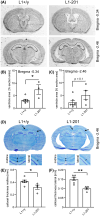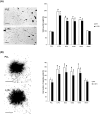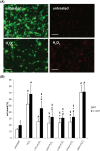Amelioration of the abnormal phenotype of a new L1 syndrome mouse mutation with L1 mimetics
- PMID: 33484186
- PMCID: PMC12315507
- DOI: 10.1096/fj.202002163R
Amelioration of the abnormal phenotype of a new L1 syndrome mouse mutation with L1 mimetics
Abstract
L1 syndrome is a rare developmental disorder characterized by hydrocephalus of varying severity, intellectual deficits, spasticity of the legs, and adducted thumbs. Therapy is limited to symptomatic relief. Numerous gene mutations in the L1 cell adhesion molecule (L1CAM, hereafter abbreviated L1) were identified in L1 syndrome patients, and those affecting the extracellular domain of this transmembrane type 1 glycoprotein show the most severe phenotypes. Previously analyzed rodent models of the L1 syndrome focused on L1-deficient animals or mouse mutants with abrogated cell surface expression of L1, making it difficult to test L1 function-triggering mimetic compounds with potential therapeutic value. To overcome this impasse, we generated a novel L1 syndrome mouse with a mutation of aspartic acid at position 201 in the extracellular part of L1 (p.D201N, hereafter termed L1-201) that displays a cell surface-exposed L1 accessible to the L1 mimetics. Behavioral assessment revealed an increased neurological deficit score and increased locomotor activity in male L1-201 mice carrying the mutation on the X-chromosome. Histological analyses of L1-201 mice showed features of the L1 syndrome, including enlarged ventricles and reduced size of the corpus callosum. Expression levels of L1-201 protein as well as extent of cell surface biotinylation and immunofluorescence labelling of cultured cerebellar neurons were normal. Importantly, treatment of these cultures with the L1 mimetic compounds duloxetine, crotamiton, and trimebutine rescued impaired cell migration and survival as well as neuritogenesis. Altogether, the novel L1 syndrome mouse model provides a first experimental proof-of-principle for the potential therapeutic value of L1 mimetic compounds.
Keywords: L1 syndrome; cell adhesion molecule L1; neuritogenesis; neuronal cell migration; neuronal survival.
© 2021 The Authors. The FASEB Journal published by Wiley Periodicals LLC on behalf of Federation of American Societies for Experimental Biology.
Conflict of interest statement
None declared.
Figures






Similar articles
-
Clinical and genetic features of L1 syndrome patients: Definition of two novel mutations.Clin Neurol Neurosurg. 2018 Sep;172:20-23. doi: 10.1016/j.clineuro.2018.06.007. Epub 2018 Jun 18. Clin Neurol Neurosurg. 2018. PMID: 29960101
-
Trimebutine, a small molecule mimetic agonist of adhesion molecule L1, contributes to functional recovery after spinal cord injury in mice.Dis Model Mech. 2017 Sep 1;10(9):1117-1128. doi: 10.1242/dmm.029801. Epub 2017 Jul 14. Dis Model Mech. 2017. PMID: 28714852 Free PMC article.
-
New generation antidepressants for depression in children and adolescents: a network meta-analysis.Cochrane Database Syst Rev. 2021 May 24;5(5):CD013674. doi: 10.1002/14651858.CD013674.pub2. Cochrane Database Syst Rev. 2021. PMID: 34029378 Free PMC article.
-
Antidepressants for pain management in adults with chronic pain: a network meta-analysis.Health Technol Assess. 2024 Oct;28(62):1-155. doi: 10.3310/MKRT2948. Health Technol Assess. 2024. PMID: 39367772 Free PMC article.
-
Thrombopoietin mimetics for patients with myelodysplastic syndromes.Cochrane Database Syst Rev. 2017 Sep 30;9(9):CD009883. doi: 10.1002/14651858.CD009883.pub2. Cochrane Database Syst Rev. 2017. PMID: 28962071 Free PMC article.
Cited by
-
Functional Diversity of Neuronal Cell Adhesion and Recognition Molecule L1CAM through Proteolytic Cleavage.Cells. 2022 Sep 30;11(19):3085. doi: 10.3390/cells11193085. Cells. 2022. PMID: 36231047 Free PMC article. Review.
-
Antagonistic L1 Adhesion Molecule Mimetic Compounds Inhibit Glioblastoma Cell Migration In Vitro.Biomolecules. 2022 Mar 12;12(3):439. doi: 10.3390/biom12030439. Biomolecules. 2022. PMID: 35327631 Free PMC article.
-
Mice Mutated in the First Fibronectin Domain of Adhesion Molecule L1 Show Brain Malformations and Behavioral Abnormalities.Biomolecules. 2024 Apr 11;14(4):468. doi: 10.3390/biom14040468. Biomolecules. 2024. PMID: 38672483 Free PMC article.
-
Interaction of L1CAM with LC3 Is Required for L1-Dependent Neurite Outgrowth and Neuronal Survival.Int J Mol Sci. 2023 Aug 7;24(15):12531. doi: 10.3390/ijms241512531. Int J Mol Sci. 2023. PMID: 37569906 Free PMC article.
-
Mice Mutated in the Third Fibronectin Domain of L1 Show Enhanced Hippocampal Neuronal Cell Death, Astrogliosis and Alterations in Behavior.Biomolecules. 2023 Apr 29;13(5):776. doi: 10.3390/biom13050776. Biomolecules. 2023. PMID: 37238646 Free PMC article.
References
-
- Maness PF, Schachner M. Neural recognition molecules of the immunoglobulin superfamily: signaling transducers of axon guidance and neuronal migration. Nat Neurosci. 2007;10:19‐26. - PubMed
-
- Sytnyk V, Leshchyns'ka I, Schachner M. Neural cell adhesion molecules of the immunoglobulin superfamily regulate synapse formation, maintenance, and function. Trends Neurosci. 2017;40:295‐308. - PubMed
-
- Schäfer MK, Frotscher M. Role of L1CAM for axon sprouting and branching. Cell Tissue Res. 2012;349:39‐48. - PubMed
-
- Harper JR, Prince JT, Healy PA, Stuart JK, Nauman SJ, Stallcup WB. Isolation and sequence of partial cDNA clones of human L1: homology of human and rodent L1 in the cytoplasmic region. J Neurochem. 1991;56:797‐804. - PubMed
-
- Sadoul K, Sadoul R, Faissner A, Schachner M. Biochemical characterization of different molecular forms of the neural cell adhesion molecule L1. J Neurochem. 1988;50:510‐521. - PubMed
Publication types
MeSH terms
Substances
Supplementary concepts
LinkOut - more resources
Full Text Sources
Other Literature Sources
Molecular Biology Databases

